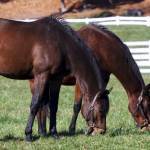The Estrous Cycle in Mares

The basis of mare reproduction is the estrous cycle, which is the time taken for the development of an egg within an ovarian follicle to the stage that it can be fertilized by a sperm, and for the preparation of the mare’s reproductive tract so that fertilization can occur.
Each stage of the cycle is controlled by hormones that are produced in the pituitary gland near the brain (gonadotropins) and in the ovaries and uterus. The level of production of the individual hormones can be affected by external factors such as day length, temperature, and nutrition, and by the presence or absence of other hormones.
About 80% of maiden or dry mares are seasonally polyestrous; that is, they have heat cycles during particular seasons of the year. The mares generally start cycling when daylight hours become longer, temperatures are higher, and nutrition improves. The loss of a mare’s winter coat usually coincides with increasing hormonal activity. The mares continue to cycle until the days start becoming shorter.
The remaining 20% of mares cycle the whole year; that is, they are polyestrous and can conceive at any time of the year if their estrous cycle is of normal length and they are ovulating. More mares will be polyestrous in tropical or subtropical areas than in temperature climates. Mares are in anestrus when there is no follicle development in the ovary. Anestrus should not be confused with the diestrus phase of the cycle (temporarily nonreceptive between regular periods of heat). Mares usually start cycling within a few days of foaling, which means they can be ready to rebreed seven to ten days after foaling.
The length of the estrous cycle is the time (in days) from the end of heat in one cycle to the end of heat in the next cycle. The day after the mare goes out of heat is the first day of the cycle and the last day of the following heat is the last day of the cycle. The average length of the mare’s estrous cycle is 21 days, which is divided into two phases. The longest phase is called diestrus (out of heat) and lasts 14 to 16 days. The length of diestrus does not vary according to season.
However, the length of the remaining phase of the estrous cycle, estrus or the in-heat period, varies greatly depending on the season. The average length is five to seven days, but longer-than-average heats are normal in early spring when the ovaries are not fully active, referred to as a transitional or spring estrus, and heats lasting up to 60 days have been recorded. The average length of each phase of the estrous cycle can also vary greatly between individual mares.








